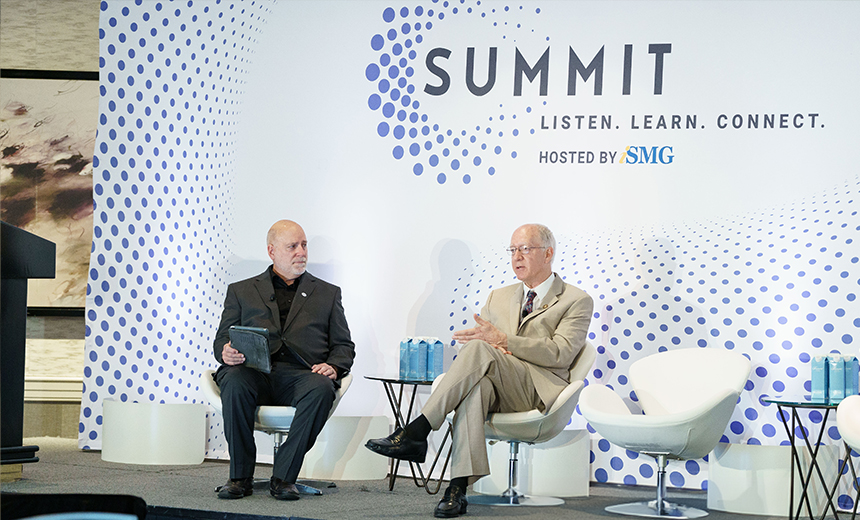Cybercrime
,
Events
,
Fraud Management & Cybercrime
Security Leaders Convene to Discuss AI Regulation and Cyber Insurance Challenges

Security leaders and policymakers convened at Information Security Media Group’s Cybersecurity Summit: North America Midwest for a day of discussion, collaboration and learning. The event centered on the transformative role of artificial intelligence in both cyber defense and attacks and also addressed regulatory challenges and strategies to combat emerging threats.
See Also: Close the Gapz in Your Security Strategy
The summit brought together industry leaders including Shefali Mookencherry, CISO and chief privacy officer at University of Illinois Chicago and CyberEdBoard member; Erik Hart, CISO at Cushman & Wakefield and CyberEdBoard member; and Kenneth Townsend, CISO at Ingredion Inc. and CyberEdBoard member, to share insights on using comprehensive metrics to obtain a mature security posture and strategies for overcoming the talent shortage in cybersecurity.
The sessions also explored secure system development and navigating the compliance maze. The sessions and networking opportunities gave attendees a deeper understanding of emerging challenges in cybersecurity governance, workforce development and regulatory compliance.
The Bipartisan Approach to AI Regulation
The rapid advancements in artificial intelligence has enabled the transformation of cybersecurity. This requires thoughtful policymaking to mitigate associated risks. In his keynote, U.S. Rep. Bill Foster, D-Ill., discussed technology initiatives in Washington, D.C., and focused on his work with the new AI Task Force. He outlined the task force’s mission to ensure America’s leadership in AI innovation and addressed crucial regulatory considerations.
Foster said that cybersecurity and AI remain nonpartisan issues, and he’s hopeful they will stay that way throughout the 2024 election cycle. He underscored the importance of collaboration between policymakers, industry leaders and security experts in shaping the future of AI governance and cybersecurity strategies.
AI in Cybersecurity: Opportunities and Challenges
In their panel discussion, Bradley Schaufenbuel, CISO of Paychex and CyberEdBoard member; Peter Tapling, board member at U.S. Faster Payments Council; Rich Campagna, senior vice president, product management, next-gen firewall, at Palo Alto Networks; and Daniel Kendzior, global data and artificial intelligence security leader at Accenture; explored how adversaries use AI to conduct cyberattacks and how enterprises use it to bolster threat detection and response. The panel also discussed how security practitioners can safely use AI to enhance security without compromising existing safeguards.
In their session titled “Mastering Cyber Insurance: Leveraging Coverage for Enhanced Security Strategy,” Keith Bergin, vice president, corporate claims, Tokio Marine HCC, and Brent Deterding, CISO, Afni Inc. and CyberEdBoard member, examined the reasons for the frequent disconnect among CISOs, vendors and insurance brokers. They discussed why traditional insurers typically offer more reliable coverage than InsurTech firms and explored the implications of minimizing application questions about premium adequacy and coverage.
“This year’s summit provided a valuable check-in on gen AI – how adversaries are employing it in their attacks, as well as how security leaders are melding it into their defenses,” said Tom Field, senior vice president, editorial, ISMG. “This conversation made the Solution Room exercise about deepfakes all the more relevant. We also benefited from open discussions about cyber insurance, software supply chain security, the skills crisis and more.”
In the interactive exercise, led by the U.S. Secret Service and Google Cloud in collaboration with CyberEdBoard members, Tim Gallo, head of global solutions architects at Google, and Brian Cockrill of the U.S. Secret Service explored ways to defend against deepfakes and fraud. This tabletop exercise allowed participants to apply theoretical knowledge to practical scenarios, enhancing their readiness to face these threats.
Other sessions at the summit covered supply chain security, regulatory compliance in a changing landscape, and strategies for bridging the cybersecurity skills gap. These discussions gave attendees a comprehensive view of the current cybersecurity ecosystem and offered insights into preparing for future challenges.
The event concluded with a call to action for continued collaboration between the public and private sectors to address the challenges and opportunities presented by AI in cybersecurity. As the threat landscape evolves, the lessons learned from this summit will be invaluable in shaping organizations’ cybersecurity strategies for years to come.
Key Takeaways
- Organizations must balance the benefits of AI in cybersecurity with potential risks and vulnerabilities.
- Comprehensive metrics and mature security postures are vital for communicating cybersecurity value to organizational leadership.
- Addressing the cybersecurity skills gap requires innovative approaches to workforce development and retention.
The Cybersecurity Summit: North America Midwest aimed to help defenders stay ahead of evolving cyberthreats through innovation, collaboration and strategic planning. Join ISMG in New York for the Healthcare Cybersecurity Summit on July 18, 2024. Discover emerging strategies and insights from industry experts to safeguard your organization against evolving cyberthreats.
This post was originally published on 3rd party site mentioned in the title of this site




